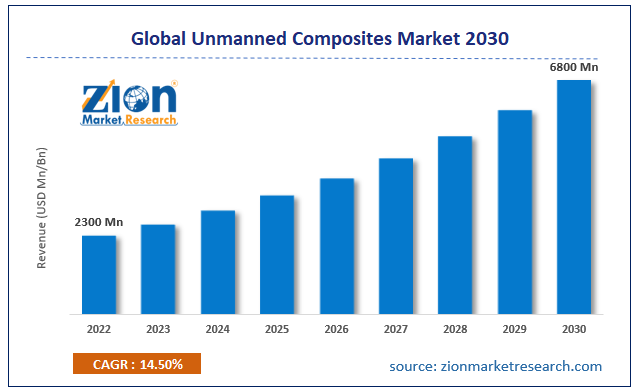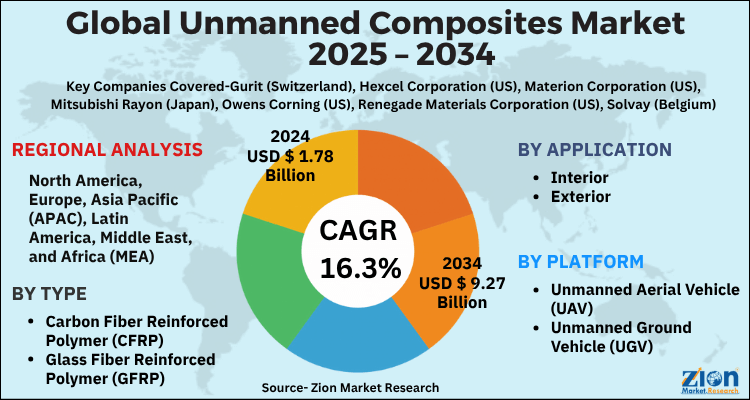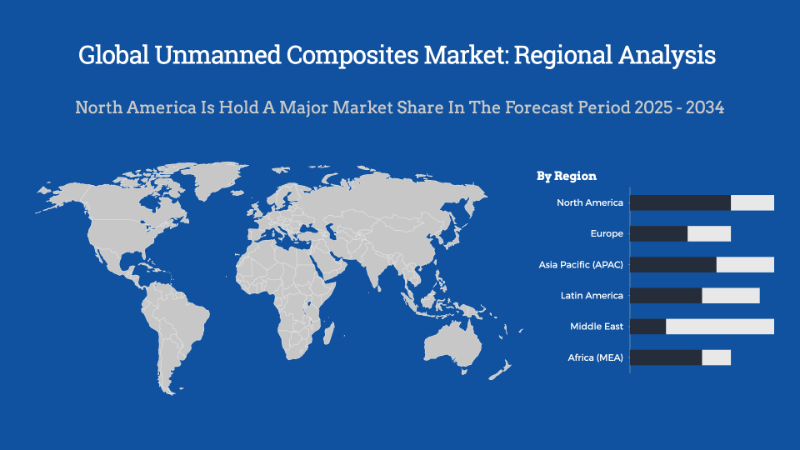Global Unmanned Composites Market Size, Share, Growth Analysis Report - Forecast 2034

Unmanned Composites Market By Platform (Unmanned Aerial Vehicle (UAV), Unmanned Ground Vehicle (UGV), Unmanned Surface Vehicle (USV), Autonomous Underwater Vehicle (AUV), Remotely Operated Vehicle (ROV), Autonomous Ship, Passenger Drone), By Application (Interior, Exterior), By Type (Carbon Fiber Reinforced Polymer (CFRP), Glass Fiber Reinforced Polymer (GFRP), Aramid Fiber Reinforced Polymer (AFRP), Boron Fiber Reinforced Polymer (BFRP)), and By Region: Global and Regional Industry Overview, Market Intelligence, Comprehensive Analysis, Historical Data, and Forecasts 2025 - 2034
| Market Size in 2024 | Market Forecast in 2034 | CAGR (in %) | Base Year |
|---|---|---|---|
| USD 1.78 Billion | USD 9.27 Billion | 16.3% | 2024 |
Global Unmanned Composites Market: Industry Perspective
The global unmanned composites market size was worth around USD 1.78 Billion in 2024 and is predicted to grow to around USD 9.27 Billion by 2034 with a compound annual growth rate (CAGR) of roughly 16.3% between 2025 and 2034. The report analyzes the global unmanned composites market's drivers, restraints/challenges, and the effect they have on the demands during the projection period. In addition, the report explores emerging opportunities in the unmanned composites industry.
Global Unmanned Composites Market: Overview
In the unmanned composites market, composite-built unmanned aerial vehicles (UAVs) or drones are developed, produced, and offered for sale. The term "composite" refers to a group of components that, when mixed, produce a substance with unique chemical or physical properties based on the qualities of the individual components. Unmanned composites are ideally suited for usage in UAVs for a range of activities like surveillance, reconnaissance, and airborne mapping since they are lightweight and tough. The market for unmanned composite materials is expanding quickly, in addition to the increased need for unmanned aircraft in the commercial, military, and client sectors. This market includes companies that create and produce composite materials as well as those that create and sell UAVs made of these materials.
Global Unmanned Composites Market: Growth Drivers
Growing demand for lightweight unmanned systems drives market growth
Composite materials are in high demand because they can provide lightweight structures and better unmanned systems. For instance, there is a considerable demand for military UAVs since they are used for maritime patrol, armed attacks, search and rescue, and aerial surveillance. As a result, there is an increased demand for unmanned composites, which is boosting the growth of the global unmanned composites market. Such UAVs employ specialized composites such as boron fiber and aramid fiber.
Restraints:
High cost and complexity in the manufacturing process impedes market growth
Compared to conventional materials like aluminum or steel, composite materials might be more costly. As a result, unmanned systems utilizing composites may have higher initial costs, which might limit their use in price-sensitive businesses. Furthermore, the production of composite components can be a complex process requiring specialized tools and manpower. Due to its intricacy, manufacturing times and expenses may go up. Thus, this is expected to impede the unmanned composites industry growth during the forecast period.
Opportunities:
Growing product launches offer a lucrative opportunity for market growth
The growing product launches are expected to offer a lucrative opportunity to global unmanned composites market growth during the forecast period. For instance, in March 2024, ARRIS, a cutting-edge producer that enables high-performance thermoplastic composites at scale for mass-market goods and industrial applications, recently unveiled "Structural Flax" as a new sustainable fiber material. Flax fiber composites for structural purposes have a 5% lower carbon footprint than carbon fiber, according to ARRIS. Thus, this kind of product launch in the market has the potential to offer a prosperous opportunity for revenue growth.
Challenges:
Quality control and limited recycling options act as a major challenge for the market growth
It's crucial to guarantee the quality and dependability of composite components, especially in safety-sensitive fields like aviation. It can be difficult, time-consuming, and expensive to meet demanding certification criteria. Additionally, recycling and environmentally friendly disposal of composite materials are frequently problematic. This presents environmental difficulties and might raise questions about the long-term effects of composite trash. Thereby, acting as a major challenge to the market growth.
Key Insights
- As per the analysis shared by our research analyst, the global unmanned composites market is estimated to grow annually at a CAGR of around 16.3% over the forecast period (2025-2034).
- Regarding revenue, the global unmanned composites market size was valued at around USD 1.78 Billion in 2024 and is projected to reach USD 9.27 Billion by 2034.
- The unmanned composites market is projected to grow at a significant rate due to growing demand for lightweight, high-strength, and durable materials in unmanned aerial, ground, and underwater vehicles across defense, commercial, and industrial sectors, alongside continuous advancements in composite manufacturing technologies.
- Based on Platform, the Unmanned Aerial Vehicle (UAV) segment is expected to lead the global market.
- On the basis of Application, the Interior segment is growing at a high rate and will continue to dominate the global market.
- Based on the Type, the Carbon Fiber Reinforced Polymer (CFRP) segment is projected to swipe the largest market share.
- Based on region, North America is predicted to dominate the global market during the forecast period.
Global Unmanned Composites Market: Report Scope
| Report Attributes | Report Details |
|---|---|
| Report Name | Unmanned Composites Market |
| Market Size in 2024 | USD 1.78 Billion |
| Market Forecast in 2034 | USD 9.27 Billion |
| Growth Rate | CAGR of 16.3% |
| Number of Pages | 209 |
| Key Companies Covered | Gurit (Switzerland), Hexcel Corporation (US), Materion Corporation (US), Mitsubishi Rayon (Japan), Owens Corning (US), Renegade Materials Corporation (US), Solvay (Belgium), Stratasys (US), Teijin Limited (Japan), Teledyne (US), and Toray Industries (Japan), and others. |
| Segments Covered | By Platform, By Application, By Type, and By Region |
| Regions Covered | North America, Europe, Asia Pacific (APAC), Latin America, The Middle East and Africa (MEA) |
| Base Year | 2024 |
| Historical Year | 2020 to 2023 |
| Forecast Year | 2025 - 2034 |
| Customization Scope | Avail customized purchase options to meet your exact research needs. Request For Customization |
Global Unmanned Composites Market: Segmentation
The global Unmanned Composites industry is segmented based on type, application, platform, and region. All the segments have been analyzed based on present and future trends and the market is estimated from 2025 to 2034.
Based on the type, the global market is bifurcated into Carbon Fiber Reinforced Polymer (CFRP), Glass Fiber Reinforced Polymer (GFRP), Aramid Fiber Reinforced Polymer (AFRP), Boron Fiber Reinforced Polymer (BFRP). The Carbon Fiber Reinforced Polymer (CFRP) segment is expected to dominate the market over the forecast period. The excellent strength-to-weight ratio of CFRP is well recognized. The design of unmanned systems, where it is essential to reduce weight while retaining structural integrity, places a premium on this attribute. Unmanned aerial vehicles (UAVs) benefit from the lighter weight of CFRP materials, which also extends flight endurance and improves agility for unmanned ground vehicles (UGVs) and undersea vehicles (UUVs). Moreover, this is extremely well suited for unmanned systems working in challenging situations, such as severe climates and maritime environments, due to its great resistance to corrosion, chemicals, and environmental variables. These systems last longer due to their increased durability, which lowers their need for maintenance and downtime. Thereby, driving the market growth over the forecast period.
Based on the application, the global Unmanned Composites industry is bifurcated into interior and exterior.
Based on the platform, the global unmanned composites market is bifurcated into Unmanned Aerial Vehicle (UAV), Unmanned Ground Vehicle (UGV), Unmanned Surface Vehicle (USV), Autonomous Underwater Vehicle (AUV), Remotely Operated Vehicle (ROV), Autonomous Ships, Passenger Drone. The Unmanned Aerial Vehicle (UAV) segment is expected to hold the largest market share over the forecast period. UAVs, often known as drones, are frequently utilized in a variety of military operations and the aviation industry. Military UAVs, which are employed particularly for aerial surveillance, law enforcement, search & rescue operations, armed attacks, and marine patrol, are in more demand. Due to the usage of specialized composites in these UAVs, such as boron and aramid fiber, the demand for composites is rising. Thereby, driving the market expansion.
The Regional, this segment includes the current and forecast demand for North America, Europe, Asia Pacific, Latin America,and the Middle East and Africa.
Global Unmanned Composites Market: Regional Analysis
The unmanned composites market shows distinct regional trends, with North America leading due to strong demand from military and aerospace sectors, significant investments in UAVs, and the presence of key manufacturers focused on lightweight, high-performance materials. Europe follows closely, driven by increasing applications in defense, surveillance, and commercial drones, supported by government initiatives promoting advanced materials and sustainability. In the Asia-Pacific region, rapid growth is fueled by expanding defense budgets, technological advancements, and rising adoption of unmanned systems in sectors like agriculture, infrastructure, and border security, particularly in countries like China, India, and Japan. Meanwhile, regions like the Middle East, Latin America, and Africa are gradually increasing their uptake of unmanned composites, spurred by security needs, industrial monitoring, and infrastructure projects, although market development remains slower compared to more established regions.
Global Unmanned Composites Market: Competitive Analysis
The report provides a company market share analysis to give a broader overview of the key market players. In addition, the report also covers key strategic developments of the market, including acquisitions & mergers, new product launches, agreements, partnerships, collaborations & joint ventures, research & development, and regional expansion of major participants involved in the unmanned composites market on a global and regional basis.
The global unmanned composites market is dominated by players like:
- Gurit (Switzerland)
- Hexcel Corporation (US)
- Materion Corporation (US)
- Mitsubishi Rayon (Japan)
- Owens Corning (US)
- Renegade Materials Corporation (US)
- Solvay (Belgium)
- Stratasys (US)
- Teijin Limited (Japan)
- Teledyne (US)
- Toray Industries (Japan)
Global Unmanned Composites Market: Segmentation Analysis
The global unmanned composites market is segmented as follows;
By Type
- Carbon Fiber Reinforced Polymer (CFRP)
- Carbon Fiber
- Matrix
- Glass Fiber Reinforced Polymer (GFRP)
- Glass Fiber
- Matrix
- Aramid Fiber Reinforced Polymer (AFRP)
- Aramid Fiber
- Matrix
- Boron Fiber Reinforced Polymer (BFRP)
- Boron Fiber
- Matrix
By Application
- Interior
- Cabin
- Sandwich Panel
- Deck
- Exterior
- Fuselage
- Engine
- Wing
- Rotor Blade
- Tail Boom
- Hull
By Platform
- Unmanned Aerial Vehicle (UAV)
- Class II (150-600 Kg)
- Class III (More than 600 Kg)
- Unmanned Ground Vehicle (UGV)
- Medium (200-500 Lbs)
- Large (500-1000 Lbs)
- Very Large (1000-2000 Lbs)
- Extremely Large (More than 2000 Lbs)
- Unmanned Surface Vehicle (USV)
- Small
- Large
- Medium
- Extra Large
- Autonomous Underwater Vehicle (AUV)
- Man Portable Vehicles
- Lightweight Vehicles
- Heavyweight Vehicles
- Large Vehicles
- Remotely Operated Vehicle (ROV)
- Small Vehicles
- High Capacity Electric Vehicles
- Work Class Vehicles
- Heavy Work Class Vehicles
- Autonomous Ship
- Passenger Drone
Global Unmanned Composites Market: Regional Segment Analysis
- North America
- The U.S.
- Canada
- Europe
- France
- The UK
- Spain
- Germany
- Italy
- Rest of Europe
- Asia Pacific
- China
- Japan
- India
- South Korea
- Southeast Asia
- Rest of Asia Pacific
- Latin America
- Brazil
- Mexico
- Rest of Latin America
- Middle East & Africa
- GCC
- South Africa
- Rest of Middle East & Africa
Table Of Content
Methodology
FrequentlyAsked Questions
In the unmanned composites market, composite-built unmanned aerial vehicles (UAVs) or drones are developed, produced, and offered for sale. The term "composite" refers to a group of components that, when mixed, produce a substance with unique chemical or physical properties based on the qualities of the individual components. Unmanned composites are ideally suited for usage in UAVs for a range of activities like surveillance, reconnaissance, and airborne mapping since they are lightweight and tough. The market for unmanned composite materials is expanding quickly, in addition to the increased need for unmanned aircraft in the commercial, military, and client sectors. This market includes companies that create and produce composite materials as well as those that create and sell UAVs made of these materials.
The global unmanned composites market is expected to grow due to increasing demand for lightweight, high-strength materials in drones and UAVs, advancements in aerospace technology, and growing military, commercial, and industrial applications.
According to a study, the global unmanned composites market size was worth around USD 1.78 Billion in 2024 and is expected to reach USD 9.27 Billion by 2034.
The global unmanned composites market is expected to grow at a CAGR of 16.3% during the forecast period.
North America is expected to dominate the unmanned composites market over the forecast period.
Leading players in the global unmanned composites market include Gurit (Switzerland), Hexcel Corporation (US), Materion Corporation (US), Mitsubishi Rayon (Japan), Owens Corning (US), Renegade Materials Corporation (US), Solvay (Belgium), Stratasys (US), Teijin Limited (Japan), Teledyne (US), and Toray Industries (Japan), among others.
The report explores crucial aspects of the unmanned composites market, including a detailed discussion of existing growth factors and restraints, while also examining future growth opportunities and challenges that impact the market.
HappyClients
Zion Market Research
Tel: +1 (302) 444-0166
USA/Canada Toll Free No.+1 (855) 465-4651
3rd Floor,
Mrunal Paradise, Opp Maharaja Hotel,
Pimple Gurav, Pune 411061,
Maharashtra, India
Phone No +91 7768 006 007, +91 7768 006 008
US OFFICE NO +1 (302) 444-0166
US/CAN TOLL FREE +1 (855) 465-4651
Email: sales@zionmarketresearch.com
We have secured system to process your transaction.
Our support available to help you 24 hours a day, five days a week.
Monday - Friday: 9AM - 6PM
Saturday - Sunday: Closed







